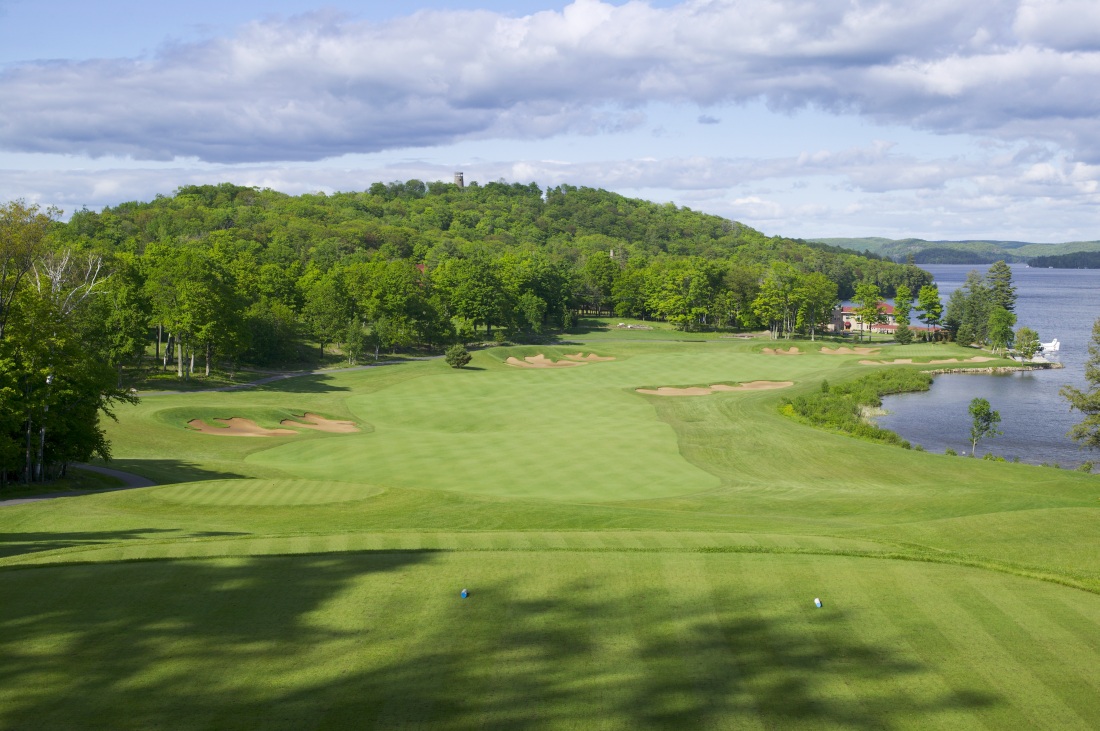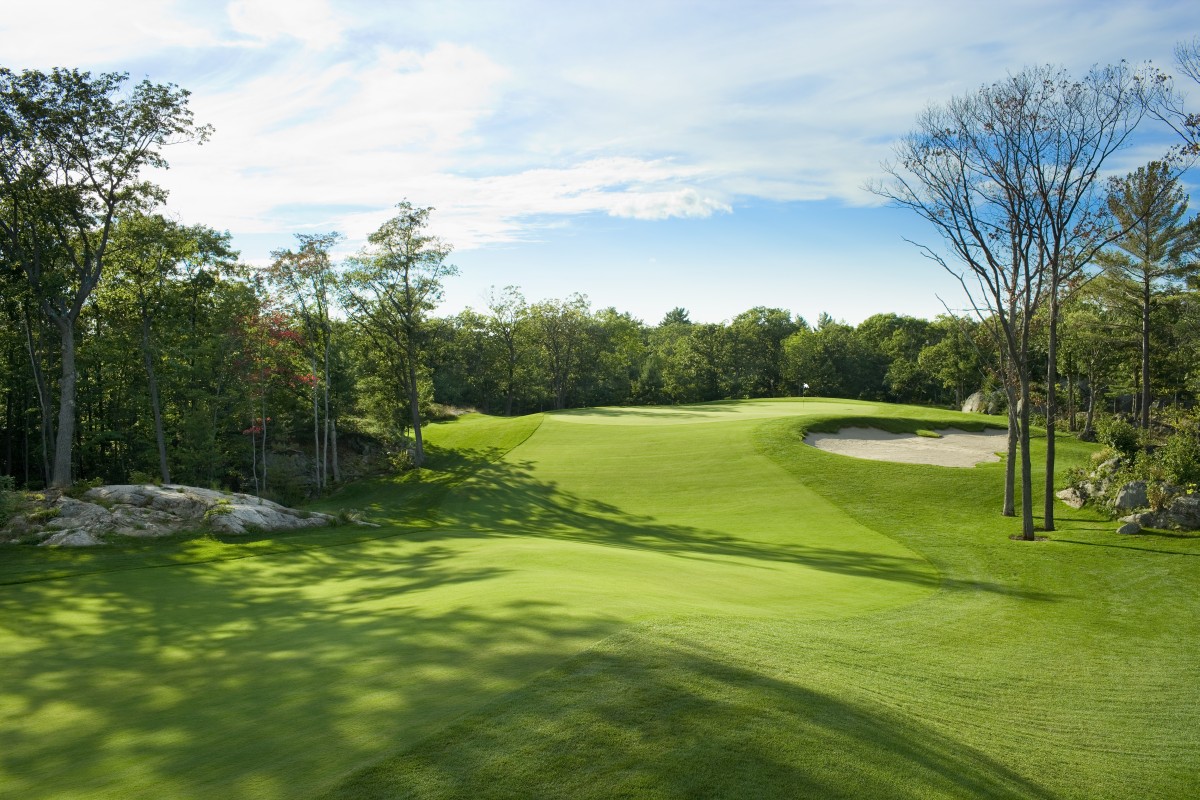The Walking Golfer is excited to present the following Q&A with Doug Carrick, a renowned Canadian golf course architect and the current President of the American Society of Golf Course Architects.
The Q&A discusses topics such as building walking friendly courses in residential communities, the future of golf course design, along with Doug’s design philosophy and how he tries to ensure that his course are enjoyable for walking golfers.
Early in his career, Doug worked with Robbie Robinson, a very well respected Canadian golf course architect who had learned from the great Stanley Thompson. Doug founded Carrick Design, Inc. in 1985, and over the past thirty-four years he has been involved in the planning and design of over fifty golf course projects, many of which have received design awards and/or acclaim from the various golf magazines. Doug has been published in numerous trade publications, invited to speak at a variety of professional conferences and recently elected President of the ASGCA by his peers as mentioned above.
Carrick Design have built many courses in the golfing hotbed of Southern Ontario including King Valley, Eagles Nest, Angus Glen, Osprey Valley, Big Win Island and their newest work at Cobble Beach. Greywolf Golf Course in BC and the River Course at Humber Valley Golf Resort in Newfoundland are two other Canadian courses Carrick has designed. Beyond the borders of Canada, Doug’s resume includes The Carrick on Loch Lomond in Scotland and two courses in mainland Europe.

Humber Valley in Newfoundland. Photo by Clive Barber and courtesy of Carrick Design Inc.
Doug and his team have been involved in designing and building many stand alone courses and others that were routed through residential communities or resorts. Carrick Design have also worked on many classic golf course renovation projects including those at Capilano, Summit and St. Georges.
Please read on for the Q&A.
TWG – With all of the courses available in the Toronto area, why did you join The Summit GC?
DC – I joined Summit more than thirty years ago, in 1978, when I was nineteen years old. At the time I was still playing some competitive golf and I felt Summit was a good test of golf that would help me develop my game to a higher level.
TWG – What are the qualities of this classic Cumming/Thompson design that appeal to you as an accomplished golf course architect?
DC – I love the seclusion and individuality of the holes. It’s a great escape from the city. The elevation changes, tree lined fairways and small greens place a premium on accuracy and the undulations in the fairways force you to learn how to play shots off every type of lie.
TWG – Do you tend to walk when you play Summit GC?
DC – Yes. When I get the opportunity to play Summit I walk, almost all the time. Only on rare occasions do I take a cart.
TWG – As a golfer and architect, do you generally prefer to walk or ride when you play or does it depend on the circumstances?
DC – My preference is to walk. Although there are some courses and/or some circumstances when it makes more sense to ride in a cart, but my preference is to walk.
TWG – Do you think walking is an important element of the golfing experience, or can a cart golfer fully appreciate the course and its design nuances while riding?
DC – I believe golfers experience more when they walk a golf course. All the senses of sight, touch, sound and smell become more engaged when walking a course. However carts have made the game more accessible to a wider range of golfers, those who have difficulty walking, and to a wider range of environments, mountain and hilly sites, where walking is difficult.

Inspiration for a walking golfer. Photo by Clive Barber and courtesy of Carrick Design Inc.
TWG – As a city, Toronto has a plethora of great golf courses, and you have been involved in a number of them. It seems like the “classic” courses are all great walks, while many of the “modern” courses are designed with carts in mind.
Is this an accurate description of a shift in design philosophy in the Toronto area over the past 25 years?
DC – I believe the shift from courses that can be easily walked to courses that are more suited to cart use has happened for a number of reasons.
First of all, many courses built in recent years have been associated with some type of residential development that is integrated within the golf course. This type of arrangement often spreads out the distance between holes to allow for road crossings and can sometimes add significant length to the overall distance to get around the course.
Secondly, carts represent a significant portion of the revenue at most golf courses and many golf course operations rely on cart use to help make their courses financially viable.
Thirdly, many of the properties that new golf courses are built on today are often not well suited to golf courses that can be easily walked due to excessive slopes, hilly terrain and significant environmentally protected areas that can lead to long distances between holes.
TWG – Can you think of any of your courses that have been built in Toronto over the past 25 years taht are an enjoyable walk?
DC – I believe King Valley, Greystone, Magna Golf Club and all the courses at Osprey Valley are relatively easy and enjoyable to walk.
TWG – Why are these such an enjoyable walk?
DC – The distances between green and tee from one hole to the next are relatively short and the terrain is relatively gentle, with not many severe climbs. The natural environments at these courses are also pleasant to experience.
TWG – How do you, or can you, influence clients to make their courses walker friendly?
DC – Whenever possible I try to design courses that can be walked with relative ease. Sometimes it is difficult to do this because of development requirements, environmental concerns or because the sites are too hilly. Most times the developer/owner determines the policy with respect to walking or mandatory carts. As architects we rarely have the opportunity to determine cart or walking policies, all we can do is try and design courses that can be walked. The rest is up to the owners.

The spectacular walk that is the course at Bigwin Island Golf Club. Photo by Clive Barber and courtesy of Carrick Design Inc.
TWG – How do you design for a walking golfer’s enjoyment if a client has made it clear that they are a priority?
DC – The key to designing a golf course that can be easily walked is to make the distances between the green of one hole and the tee of the next hole as short as possible, while keeping in mind safety concerns. It is also important to design the course routing in such a way that severe slopes or elevations changes are utilized on downhill holes and more gradual slopes and elevation changes are used on uphill holes. It is also important to make uphill climbs in stages whenever possible, rather than all at once.

Integrating elevation change into the design is critical. Photo by Clive Barber and courtesy of Carrick Design Inc.
TWG – Is it more difficult to design a walking only, or walking friendly course, versus a cart golf course based on your experience with a wide range of terrains across Canada?
DC – Walking courses are far more challenging to design today than they were in the past because of the nature of the present day sites, which tend to be more severe with more environmental restrictions, and also due to the demands for residential development associated with many modern golf courses.
TWG – How can an architect decrease the impact of cart paths on courses? That is – visually, in terms of path cost and maintenance, in terms of turf impact and repair.
DC – An architect can reduce the visual impact of cart paths by keeping them well back from play areas and by screening them from view through treed areas or by routing paths behind rolls and undulations in the fairways. Paved cart paths are far more cost effective to maintain than gravel cart paths, and they also tend to have a longer life span. Turf wear problems can be greatly reduced by avoiding cart traffic that enters and exits paths at one point. It is better to have carts entering and exiting paths at a variety of locations or at an oblique angle to the path.
TWG – Is it possible to route a great walking course through a residential community?
DC – It really depends on the amount of integration of homes and golf holes. Courses that have home lining both sides of every fairway tend to have more road crossings between holes which lengthens the overall distance walked. Courses that only have homes located on the perimeter of the golf course are generally more compact and distances between greens and tees can be reduced. So the answer is yes depending on the design approach taken.
TWG – Can you give examples of a couple of your projects that struck a great balance between real estate development and walkability?
DC – Certainly. I think Magna Golf Club and King Valley Golf Club are both good examples of this.
TWG – In a recent article, you mentioned that the time management issues that we face in modern society will probably force, or lead to, the creation of shorter courses that are faster to play. How will the architect maintain interest and challenge while improving speed of play on these shorter courses?
DC – More compact course designs with shorter distances between greens and tees, shorter overall course length, keeping in mind that 90% of golfers have great difficulty managing a course in the 7,000 yard range, will no doubt help to reduce the length of time it takes to complete 18 holes.
I believe the challenge and character can be maintained through good strategic design, great variation in hole lengths so that all clubs in the bag are used, this can be achieved most easily by creating variety in lengths on the par threes and par fives. Undulating fairway and green contours can also add great interest and challenge to a course without the need for excessive length.
TWG – Do you think technology should be “frozen” or “rolled back” to a previous period in order to make shorter courses as challenging as today’s 7+ thousand yard “championship” layouts?
DC – I believe that the distances the golf ball flies should be rolled back. Trying to change club technology is too complicated and has too many variables. Changing the ball is much easier. Golfers will still lose golf balls whether or not they fly farther or shorter, so a change to the golf ball shouldn’t hurt ball sales.
I believe our generation today has more pressure to balance their time between work, family and leisure activities. Golf will suffer if we keep building courses that take longer to play and cost more money to build, maintain and play. The cost of land continues to escalate and protection of our natural resources is becoming more and more important. We can’t continue to consume larger and larger tracts of land for golf.
Because of these factors I believe the ball should be rolled back in order to ensure future growth in the game. Or we design shorter courses and accept the fact that skilled players will only need three clubs -driver, wedge and putter.
TWG – Do you envision courses of the future being more or less walking friendly?
DC – I hope and believe that the majority of future courses will be walker friendly.
TWG – How can golf course developers and architects be more responsible to the environment in terms of construction techniques and future course maintenance?
DC – Developers and architects can be more responsible by respecting the sensitive natural features that need to be protected, by using water more efficiently and by incorporating natural areas in non- play portions of the golf course to encourage the flourishing of wildlife and natural vegetation.
TWG – From your portfolio, it is obvious that you have a gift for adapting your style to the terrain and environment at each site. What is your thought process in determining what “style” is right for a course and how do you go about preparing your initial design thoughts?
DC – Determining the style for a golf course is primarily derived from looking at the natural character of the site and designing features that are sympathetic to the character of the site. In cases where the site has limited natural character, we often consider what is offered at other courses in the same market area and how we can design something that offers a different golf experience than what is already offered.

The routing must flow naturally through the site. Photo by Clive Barber and courtesy of Carrick Design Inc.
TWG – Which three Carrick designs are your favorite walking courses and why?
DC – The Carrick on Loch Lomond, Osprey Valley Heathlands Course and King Valley Golf Club are my favorite walking courses. All of these courses are relatively compact, with easy walks from green to tee and they are in beautiful natural settings.
TWG – You are extremely well known and respected in both Canada and your industry, which is evident by the recognition that your designs have received and your appointment as President of the ASGCA. Is there a specific reason that you have not designed any courses in the US?
DC – The US golf course design market is very competitive, especially among the “celebrity” or well known designers. All of the Canadian Designers have been challenged to gain notoriety or recognition for the work south of the border. I believe it comes down to lack of familiarity with the work being done by Canadian designers, south of the border. Not that we haven’t tried to secure projects in the United States, it just hasn’t happened yet. I hope that once we do one project in the US that others will follow.
TWG – How important to the client was “walkability” in your design at Loch Lomond?
DC – Walkability of the course at Loch Lomond was a primary consideration in the design of the course, as it is a big part of the golfing culture in Scotland.
TWG – How did it impact your routing of the course, if at all?
DC – It encouraged me to find a routing that allowed for easy walking with short distances between greens and tees and gradual climbs going uphill and steep drops going downhill. My goal was to avoid any strenuous climbs, especially on the back nine which is located in the undulating terrain of the Highlands of Scotland.
TWG – Has designing and building a course in Scotland changed your philosophy as an architect in any way?
DC – Having the opportunity to see and play many of the great links courses in Scotland, while building the course at Loch Lomond certainly gave me a much deeper appreciation for many different qualities found on the links courses such as: fairway undulations and irregularities, green contours, small but penalizing bunkers, courses that can be played in 3 hours or less, reduced maintenance requirements, firm, fast and dry fairways and greens, walking and the traditions of the game.
TWG – Thank you again for taking the time to answer our questions.
DC – You’re welcome.

Enjoyed reading your article on design. Brings me to a question about balance of par 3/4/5 holes. It seems to me that Stanley Thompson designs had more variety in the balance of these three types. I have not played even half of his designs, but I have played on some that have 6/6/6 balance of the par 3/4/5 respectively, and have gone through 6 holes without even playing a par 4. But it seems that all current designs seem to favour a balance of 4/10/4. Thompson was constrained with a lack of horsepower to create designs, but now with more HP available, it seems that we get less creative in balancing types of holes. What constraints do you face in balancing the mix of par 3/4/5? Is the marketplace putting this constraint on the architect?
I have followed this site for several months and find it very interesting although I play most of my golf in the UK in summer and South Africa in winter. We have just under gone a 7 hole alteration to our home course. The first hole is a par 4 hole at 472 yards in length on fairly flat terrain. However, the architect has has positioned two cross bunkers 30 yards from the front of the putting green, making an approach for most club golfers impossible via the front apron. The ball has to be flown over these bunkers to land on the green. Most golf architects books I have read seem to recommend that on a long par 4 there should always have entry to the green via a running approach (long iron) shot through an opening to the front of the green with bunkers probably either side to collect the errant approach shot.
However, in our case we have no possibility for this shot but the architect has placed a bail out area to the right of these bunkers similar to what you now find on a long par 5 hole. This philosophy seems to be at odds with most golf architects views on long par 4 holes. The average members have great difficulty with this hole and play it as a par 5 which is a great shame for an opening hole.
I would be interested to here Doug’s views on this. Incidentally I have played “The Carrick” and stayed in the hotel. I will go back as it was a fantastic experience, I am a 5 handicap walking golfer and always walk unless forced into a cart.